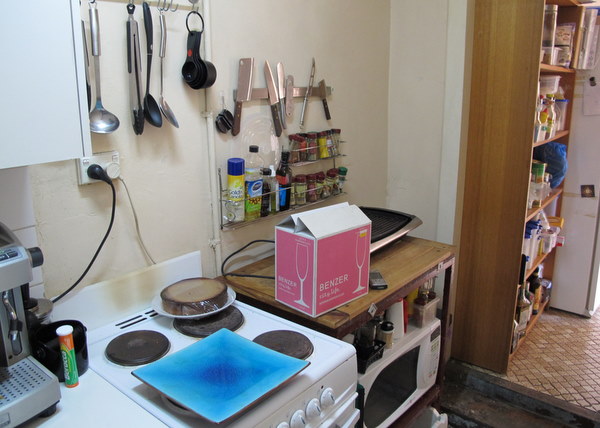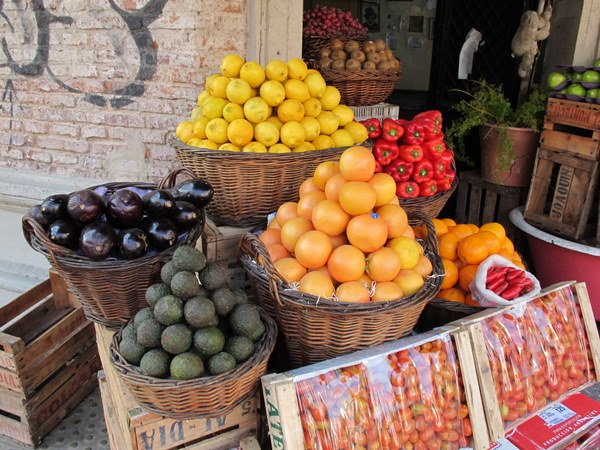When we first viewed our pokey little townhouse in Alexandria 4 years ago, Senhor R was doubtful. ‘But we can’t cook in that kitchen!’ He said. But since I do the cooking, we took the house, and I took on the Corridor Kitchen as my personal challenge, determined to conquer it.
As we move out now, I can’t say I haven’t bitched about the kitchen constantly; the lack of exhaust fan, the florescent lighting, the lack of bench space, the damp, the mould, the lino, oh yes, AND THE FACT THAT IT FLOODS EVERY TIME IT RAINS. Or did, until last month. But the fact is, I’m a much better cook than I was 4 years ago, and the kitchen is why. What follows are the top 5 lessons I learned from cooking in my Corridor Kitchen.
Lesson One: Neccesity really is the mother of invention.
If you have an ok kitchen with only a few irritating aspects, chances are you can let them slide – not quite enough cupboard space? Get rid of some stuff. Small sink? Grin and bear it. But if your kitchen is very basic, you will be making improvements. Constantly. And your creativity will know no bounds.
When it came to ideas for our kitchen, there were literally no wrong answers. And as an added bonus, the kitchen was so ugly that it didn’t matter what we did to it. We were free to focus completely on utility and throw aesthetics out the window. This was actually incredibly liberating and…
- We came up with an ingenious combination of hanging rails, hooks and magnetic strips to hold our knives and most used utensils.
- We bought a massive bookshelf from a law firm that went into liquidation to use as our pantry.
- Friends donated us a kitchen island made out of an old artist’s trolley.
- Senhor R rigged up a complex system of extension cords and powerboards so that we could have more than just two appliances in our kitchen. So what if I could never use the microwave at the same time as the kettle. *
Lesson Two: lack of storage can actually be a good thing.
It sounds completely crazy, but as I move into my new kitchen which seemed initially to have so much storage, it has become very apparent that the important thing is not how much storage you have, but the quality of that storage.
In a ramshackle custom-altered kitchen like the Corridor, we were forced to create our own storage, thus that storage was custom designed for us. The kitchen became a work-in-progress (as much as it could in a rental property) and was user friendly precisely because it was user designed. Commonsense aspects of this design included;
- Eye-level storage
- A combination of visible and hidden storage.
- Prioritising items based on frequency of use.
I found this post over at Small Notebook invaluable in our old house.
Lesson Three: The bench tops are always shinier in the kitchen next door.
When I viewed the apartment we’re moving into now, I was blown away by the kitchen. But now that we’re unpacking our stuff, there are aspects of the Corridor Kitchen I’ve really come to appreciate. The massive pantry made of bookshelves, for example, or space for a bin.
Although I know that not everything in the new kitchen can be perfect, I guess when I was working within the ridiculously rigid constraints of the old one, I figured that every kitchen out there was better than mine, in every way. But of course there are things about the new kitchen I don’t like. I’d rather have more cupboards than a dishwasher, for example. I crave more shelves inside the cabinets.
Lesson four – I love shelves!!
Shallow, open shelving makes everything visible and you always know what you have. I never really appreciated this until now. In our last place, most of our belongings were stored on shelves because there was no built in storage except for the kitchen cabinets.
Turns out we can’t just throw all these shelves away and what’s more, in some ways they are actually better than ‘real’ storage. This is especially true in the case of food, where they make everything accessible and visible. Who cares if the outside of your olive oil bottle gets dust on it?
Lesson five: ‘Useful’ items aren’t always that useful.
Too many of a useful thing is still too many things! I’m looking around at our one million plastic containers and our one million pyrex containers thinking…what the hell do we need all these for again? Why do I have 4 frypans? What’s the logic behind out two sets of cutlery?
I guess I assumed that because we had limited space in our old kitchen, everything in there must have been necessary. But of course that’s not the case. When there’s space we tend to fill it – you never find an empty kitchen drawer.
What about you? What lessons have you learned from your kitchen?
* When my Dad came to stay he was pretty worried we’d end up electrocuting ourselves.
1. The Presentation of all things Food
Crisp white tablecloths without paper covers. The old-world charm of BA restaurants. And more recently, the beautifully arranged fruit and vegetable stands in every neighbourhood. Although the aesthetic can be homogeneous, there is something lovely about the Porteños’ eye for detail when it comes to food.
2. Cake is sold by weight
In panaderias, smaller cakes, pastries and biscuits from medialunas (small croissants or ‘half moons’) factures to alfajores are often sold by weight rather than quantity. There’s something very decadent about ordering half a kilo of a combination of meringue, dulce de leche and sponge cake to take away.
3. Fresh OJ
Fresh Orange juice is like running water here and not, in the words of Basil Fawlty, ‘rather sticky’. Cafés, restaurants and confiterias all make and serve it, as do some convenience stores and market stalls. It makes that breakfast of coffee and pastry seem a tad more balanced.
4. Garapiñadas
These sugar-coated nuts, usually peanuts or almonds, are cooked and sold by the side of the road in autumn and winter. In the mornings you can see the vendors wheeling their carts to their allocated spots for the day. It’s the kind of snack that is considered gourmet and is expensive where I come from, but here in Buenos Aires a small packet of garapiñadas costs only 2 or 3 pesos (about 50 Aussie cents). Freshly made and with fresh peanuts, they are more addictive than peanut butter. And since peanut butter doesn’t really exist here, they make a tasty substitute.
5. Delivery
One of the most fantastic things about this city, besides most restaurants being open until around 2:00 am is that practically anything you want can be delivered. You want empanadas at midnight? Done. A coffee and a medialuna at 10:00 am? No worries. Most shopfronts have their phone number displayed so that customer can ring up and order what they like. It’s not uncommon to see waiters with a covered tray in hand dodging traffic as they try not to spill coffee for someone a few doors down. There’s no minimum delivery and no delivery charge.
About me
 Sharing easy recipes, hunting down the best coffee. Honest accounts, nothing too serious. Read more...
Sharing easy recipes, hunting down the best coffee. Honest accounts, nothing too serious. Read more...Recent Posts
- Aerpress means no more shit #travelcoffee and #workcoffee
- Why I write and four ace bloggers who do it better
- The five best things I ate in London
- Shoreditch is awesome, airports are not
- I quit sugar? Do I bollocks.
- Cubao Street Food, Alexandria
- The Reformatory Caffeine Lab, Surry Hills
- Brewtown Newtown
- Stay caffeinated over Christmas
- Gumption by Coffee Alchemy, Sydney CBD
Popular posts this month…
 Sparkling Long Black posted on May 10, 2011
Sparkling Long Black posted on May 10, 2011  Review – Philips Saeco Intelia posted on January 10, 2012
Review – Philips Saeco Intelia posted on January 10, 2012  Kosher Whole Orange Cake posted on July 5, 2011
Kosher Whole Orange Cake posted on July 5, 2011  Cheat’s Dulce de Leche posted on January 7, 2011
Cheat’s Dulce de Leche posted on January 7, 2011  The quest for Mex part 2 – Feisty Chicken Burritos posted on December 21, 2010
The quest for Mex part 2 – Feisty Chicken Burritos posted on December 21, 2010  Café Review – Petty Cash Cafe, Marrickville posted on May 31, 2011
Café Review – Petty Cash Cafe, Marrickville posted on May 31, 2011  Salat Hatzilim posted on January 28, 2011
Salat Hatzilim posted on January 28, 2011  Sri Lankan Spinach with Coconut posted on December 10, 2010
Sri Lankan Spinach with Coconut posted on December 10, 2010
Disclaimer:
All opinions in this blog are mine, an everyday, real-life person. I do not accept payment for reviews and nor do I write sponsored posts. I do not endorse the content of the comments herein.














